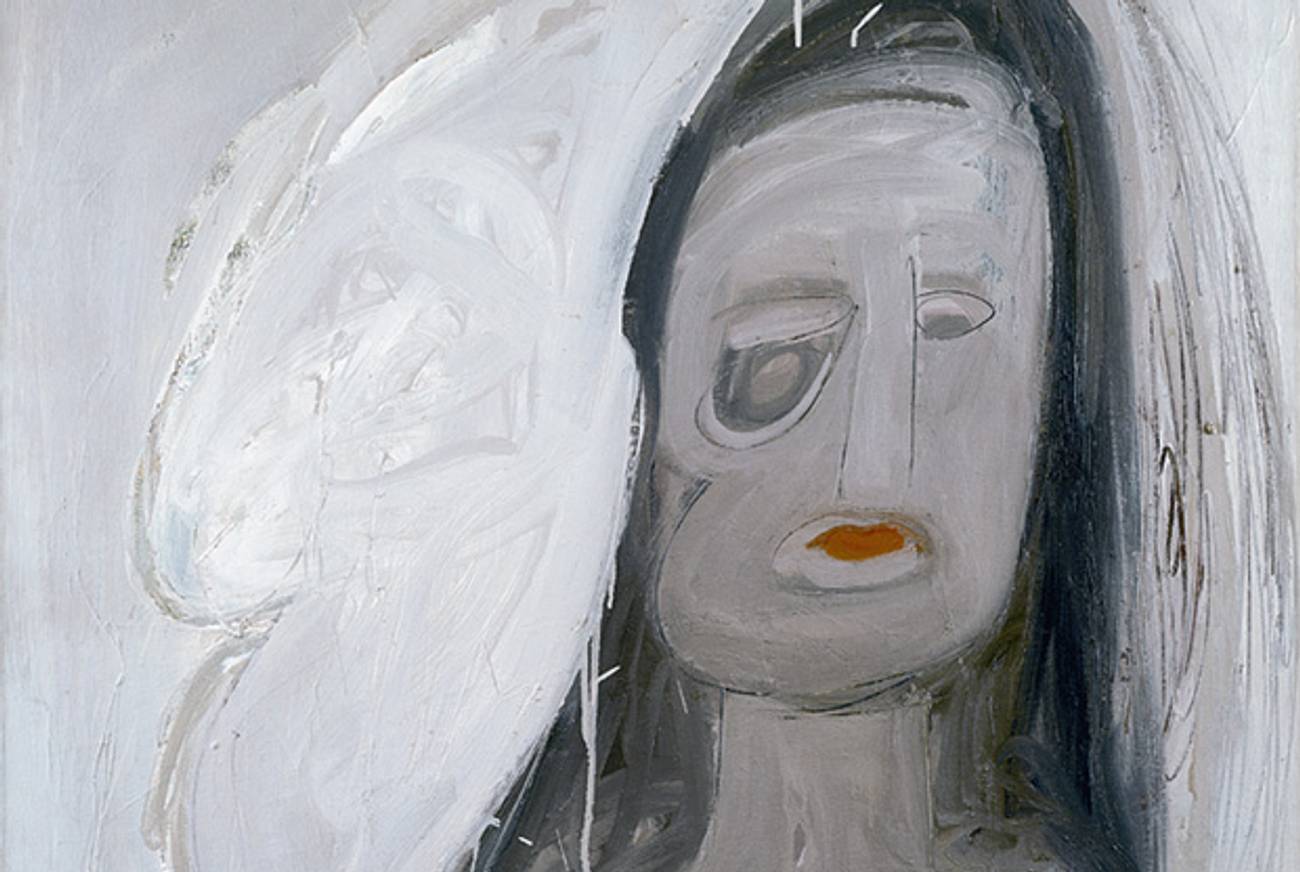Haunted
A show of early paintings by Eva Hesse at the Brooklyn Museum neglects the Jewish history that framed and influenced her art




In February 1960, soon after Eva Hesse had graduated from Yale and moved to New York, she made a note in her diary. “Received [$]1,300.00 from grandparents stay in concentration camp,” wrote the artist, who had fled Germany on a kindertransport as a child. “I will make use of the money wisely. I will go on my own, paint and get in a show and be in a gallery. It is all going so much quicker than anticipated.”
The passage, quoted in the catalog from a 2006 exhibit of her work at the Jewish Museum in New York, is bittersweet in so many ways. Because, of course, Hesse got in a group show the next year and went on to become an internationally admired artist before succumbing to brain cancer in 1970, at 34. It’s not her painting she’s most remembered for, though: It’s how she parlayed non-art, non-heroic materials—cord, gauze, latex, fiberglass—into intellectually rigorous, elegantly humorous, implicitly erotic post-minimalist sculpture.
The paintings she made in 1960 don’t look anything like that: They’re like de Koonings and Giacomettis with their flesh dripping, and their eyes gouged out. With anxious, messy strokes, Hesse conjured ghastly girlish faces with piercing yellow eyes, creepy humanoid forms resembling skeletons, zombies, and aliens, bloated female figures colliding, and a spectral bride who is haunting or haunted by a phantom. The artist, trained in color theory by Josef Albers, deployed a grayish palette, “both ashen and sallow, highlighted with accents of the nauseous,” as E. Luanne McKinnon puts it in the catalog for the current Brooklyn Museum exhibition of 19 of these paintings, from a series thought to include 21. McKinnon titled the show “Spectres,” for its meaning “image or apparition.”
Whether the artist would have approved of the exhibition is a mystery. Apparently Hesse never showed these paintings to anybody, except, evidently, one or more to her psychiatrist (who ended up owning one, a disfigured face thought to be a self-portrait). Perhaps they were too personal? Of all her work, the paintings seem to most closely express Hesse’s childhood traumas: her escape from the Holocaust, her painful youth—marked by her parents’ divorce—in the Washington Heights neighborhood of Manhattan, and, when Hesse was 10, her mother’s suicide.
Or maybe Hesse intuited they’d be bad for her career. Clearly the path out of minimalism, wherever it went, wasn’t through de Kooning. Retrograde in medium, execution, and tone, the “Spectres,” unseen during the artist’s life, fell into oblivion after her death. Even in the 1980s, when expressionism had its comeback (and the art world marveled at Robert Smithson’s own de Kooningesque aliens, painted around the same time as Hesse’s)—the “Spectres” remained out of view, in the artist’s estate. A few first appeared in public in Hesse’s 1992 retrospective at Yale. Exhibited intermittently ever since, the paintings weren’t assembled as a group until this show.
For the catalog’s authors, the occasion presented a bit of a minefield. The paintings, the texts suggest, are a “reckoning”: According to the writers, they show the artist careening between abstraction and figuration, experimenting with ways to express anxiety, explore identity, comment on gender, investigate the “dream-culture” of the New York art world, and recapitulate Jungian archetypes, among other things. The artist’s biography plays a part too, the authors say. They describe how these works reflect Hesse’s emotional states—fear of parental abandonment, displacement, and loss—and her survivor mentality.
What Hesse survived is barely noted, however. The Holocaust is “past trauma” and “historical catastrophe.” No one mentions that Hesse lost family, including grandparents, in that catastrophe. No one discusses the possible connection of these flayed figures to concentration camp victims. In a show of skeletons and ghosts, the omission seems a bit weird.
Other aspects of Hesse’s story are conspicuous by their absence, too. Authors including Freud, Descartes, Derrida, Lacan, Jean-Francois Lyotard, Elizabeth Bishop, Julia Kristeva, Luce Irigaray, Hélène Cixous, Adrienne Rich, Doris Lessing, and Maurice Merleau-Ponty, come to play in discussions of self-abnegation, dream-distortions, feminine duality, and other motifs scholars see in the work. But no one mentions Anne Frank, whose diary Hesse had been reading (as she mentioned in her own) and with whom she identified because she could have shared the same fate. Or Leon Uris, whose novel Exodus inspired Hesse’s decision to use her restitution money to pursue her art career, as she wrote in that February 1960 diary entry. The authors cite everything from Easter Island statues to a Kwakiutl totem pole to a Siberian tale of a maid who takes a skull as her groom, to how Mary Shelley’s Frankenstein prefigured Hesse’s haunted bride. But there’s no reference to the dybbuk—or any aspects, for that matter, of the religion and culture the artist grew up in.
This isn’t to suggest that the works are Jewish pictures, or Holocaust pictures. They certainly come off more as existentialist metaphors than cathartic reportage. But it doesn’t mean they’re not Holocaust pictures, either.
It does seem, though, that the catalog’s authors, however unintentionally, decided that some information was “too Jewish” to include. In their effort to universalize Hesse’s message, they de-Judaized her. Ironically, or not, this is the same thing that happened to Anne Frank. Maybe she’s the spectre haunting the Brooklyn Museum show after all.
Robin Cembalest is executive editor of ARTnews. She blogs at letmypeopleshow.com. Her Twitter feed is @rcembalest.
Robin Cembalest is executive editor ofARTnews. She blogs at letmypeopleshow.com. Her Twitter feed is @rcembalest.